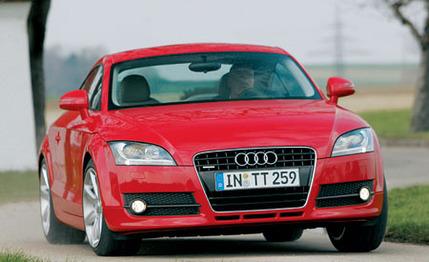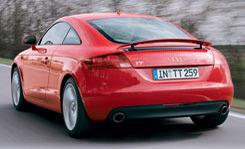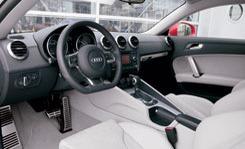
 First Drive Review
First Drive Review
Audi chairman Martin Winterkorn says proudly that the TT "is an icon." The car's critics, on the other hand, always regarded the first-generation TT as a slightly sportier Volkswagen GTI dressed in a mighty fine party frock. When it went on sale in the U.S. in 1999, it aimed to compete with the Mercedes-Benz SLK and BMW Z3. The second-generation car, which goes on sale here early in the summer of 2007, is pitched even more ambitiously against the Porsche Cayman.
The new TT shares some of its architecture with the latest Golf, but it now shares less with its VW sibling than the first-generation car. Like the Golf, it has grown up in the intervening years and now measures 164.5 inches long and 72.5 inches wide, up by 5.4 and 3.1 inches, respectively. The most radical change is that it uses a combination of a unit body and aluminum space-frame construction, with 69 percent of the structure being aluminum and the remainder steel. As a result, the '08 TT is about 200 pounds lighter than its predecessor.
Maybe you recall that some early TT models wound up in high-speed crashes on Germany's autobahns, after which Audi fitted cars with a tail spoiler. Mindful of this, the new car has located another three percent of the car's weight over the rear end, giving a more equitable 55-to-45-percent front-to-rear distribution on all-wheel-drive models, and there is a spoiler integrated into the trunklid that rises at 75 mph and lowers at 50 mph.
Like the last TT, the '08 car has a choice of two engines. The base vehicle gets a 2.0-liter direct-injection four-cylinder turbocharged engine making 200 horsepower (versus 1.8 liters and 180 or 225 horsepower in the previous model). As before, there is also a 3.2-liter V-6 that produces 250 horsepower. Both models have a standard six-speed manual transmission, with an available dual-clutch gearbox that Audi now calls S tronic (formerly DSG). The four-cylinder car will be front-wheel drive only at launch, although you can bet it will be available at a later date with the Quattro system that is standard on the 3.2. Audi claims the 2.0 will sprint from 0 to 62 mph in 6.4 seconds and reach a top speed of 149 mph and the 3.2 will run 0 to 62 mph in 5.7 seconds and top out at a governed 155 mph.

 From the outside, the TT looks like a refined, bigger version of the outgoing model, with styling that incorporates the now familiar (and massive) Audi grille. Inside, something's lacking. The old car's interior was a riot of flashy style, with bespoke detailing and design. The new car has some cool features, such as a flat-bottom steering wheel and aluminum air-vent surrounds, but the effect is more scaled-down Audi sedan than a development of the old sports car. Of course, the materials are exceptionally high quality, but it doesn't capture the emotions like the last one did. The seating position is excellent, and the wider body gives more passenger space, but the rear seats are sized for kids only. Better to fold them down and increase the luggage space from 10 cubic feet in the trunk to a healthy 25 cubic feet. Ordering the optional navigation system saddles the buyer with Audi's Multi Media Interface, the company's (mildly improved) version of BMW's iDrive controller, which may be a good reason not to tick that option box.
From the outside, the TT looks like a refined, bigger version of the outgoing model, with styling that incorporates the now familiar (and massive) Audi grille. Inside, something's lacking. The old car's interior was a riot of flashy style, with bespoke detailing and design. The new car has some cool features, such as a flat-bottom steering wheel and aluminum air-vent surrounds, but the effect is more scaled-down Audi sedan than a development of the old sports car. Of course, the materials are exceptionally high quality, but it doesn't capture the emotions like the last one did. The seating position is excellent, and the wider body gives more passenger space, but the rear seats are sized for kids only. Better to fold them down and increase the luggage space from 10 cubic feet in the trunk to a healthy 25 cubic feet. Ordering the optional navigation system saddles the buyer with Audi's Multi Media Interface, the company's (mildly improved) version of BMW's iDrive controller, which may be a good reason not to tick that option box.

 As the 3.2-liter car goes on sale in Europe first, that's what we drove. The engine sounds unspectacular on startup, an impression that remains throughout the rev range. The power delivery is smooth from about 2200 rpm up to 6400, with a more voluble voice making itself known about two-thirds of the way around the tach dial. The S tronic transmission is as seamless as it is in other Audi and Volkswagen products and allows you to drive as the mood takes you: relaxed in automatic, frenzied with the manual paddle shifters. The car is fast, but it's comfortably quick rather than spectacular.
As the 3.2-liter car goes on sale in Europe first, that's what we drove. The engine sounds unspectacular on startup, an impression that remains throughout the rev range. The power delivery is smooth from about 2200 rpm up to 6400, with a more voluble voice making itself known about two-thirds of the way around the tach dial. The S tronic transmission is as seamless as it is in other Audi and Volkswagen products and allows you to drive as the mood takes you: relaxed in automatic, frenzied with the manual paddle shifters. The car is fast, but it's comfortably quick rather than spectacular.
The new TT is certainly a lot more stable than the old one. It even feels better than a Porsche Cayman at high speed, especially in side winds. All TTs have strut-front and multilink-rear suspensions, but there is now an optional adjustable suspension system with magnetic shock fluid. There are two settings, sport and comfort. The sport setting certainly firms up the shocks and limits roll, but the comfort setting feels more natural in this car. There's plenty of grip from the 245/40 Michelin Pilot Sport tires that are fitted on 18-inch rims, the steering is sharper, and you can feel what all four tires are doing. But the TT still tends to understeer at the limit, and that limits the fun.
The 2008 Audi TT is more technically refined and looks more aggressive, but it's still not a true sports car. Yes, it drives more entertainingly than the previous car, but it has lost some of its purity and charm in the makeover. It is faster, the handling is more precise, and it is easier and safer to drive at the limit, but if you're looking for a way to increase your pulse rate, it just isn't as invigorating as a Cayman.